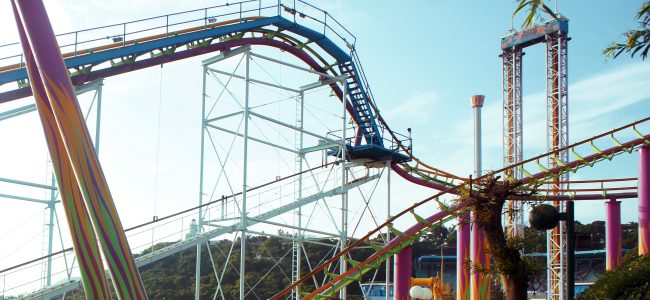BlogLine
In Huzinec v. Six Flags Great Adventure, the Third Circuit weighs in on roller coasters, mobile devices, and the Federal Rules of Evidence
6/1/23

In Huzinec v. Six Flags Great Adventure, 2023 WL 1433633 (3d Cir. February 1, 2023), Plaintiff, Evan Huzinec, claimed he had suffered serious injuries while riding a roller coaster, El Toro, at Six Flags’ New Jersey amusement park. During the ride, a fourteen-year-old fellow patron dropped her cell phone, which hit Huzinec on the head. Huzinec alleged that Six Flags was negligent in failing: (1) to enforce its loose objects policy by instructing the other patron while she was queuing for El Toro; (2) to secure the other patron’s cell phone; (3) to supervise the other patron’s compliance before and during the ride; and (4) to stop the ride once the patron unsecured her cell phone. Additionally, Huzinec alleged the amusement park’s loose objects policy was unreasonable because of the foreseeable risk that patrons might unsecure their mobile devices during the roller coaster ride.
At the District Court level, Six Flags moved for summary judgment, which the court granted, holding that in order to prove his negligence claim Huzinec required an expert to establish the standard of care. The District Court reasoned that “developing safety policies for theme park patrons is not a common issue within the ken of a jury.” In support of its ruling, the District Court pointed to two New Jersey Superior Court opinions, both unpublished, which required expert witness testimony to establish the standard of care in setting policies for theme park patrons. In the first case, Velasquez v. Land of Make Believe, the Superior Court determined the plaintiff needed expert testimony to help jurors understand the regulatory scheme that the New Jersey Carnival-Amusement Rides Safety Act (CARSA) imposed on a water park’s operators insofar as it related to the plaintiff’s allegations that overcrowding led to her being stepped on and injured by another patron. In the second case, Bomtempo v. Six Flags Great Adventure LLC, the Superior Court determined that expert testimony was required to establish the standard of care where a plaintiff sustained a spinal fracture on a waterpark ride after the raft she was riding on slammed into the base of the ride. The Bomtempo Court reasoned “that operation and maintenance of the attraction at issue require[d] a thorough comprehension of the attraction’s standard operating procedures,” and those procedures required “ride attendants to learn and understand an extensive body of particularized terminology regarding aquatic safety.”
The Third Circuit disagreed with the District Court’s analysis, concluding New Jersey law did not require Huzinec to produce an expert to identify the standard of care. The Court of Appeals reasoned that Huzinec’s injury did not stem from complexities and variables requiring an expert to help a jury understand the standard of care; nor was his injury the result of El Toro’s design or the mechanical operations of the ride, as in Bomtempo. Rather, Huzinec’s injury occurred when someone dropped a cell phone and it hit him on the head. The Court believed that the average person can understand the risk Six Flags created by permitting patrons to carry unsecured cell phones on a roller coaster.
The Third Circuit further disagreed with the District Court’s evaluation of two pieces of evidence Huzinec adduced to show Six Flags was on notice about the danger of its loose-articles policy: (1) a 2013 incident report documenting a Six Flags patron’s injury where the patron suffered “lacerations to the forehead” from a cell phone falling and hitting him; and (2) ten YouTube clips that Six Flags patrons purportedly filmed while riding El Toro. The District Court concluded that Huzinec’s claims that the duty of care was breached failed because “he does not provide any substantive information about the prior injury, aside from the bare-bones, one-sentence incident report itself, on the basis of which a jury could reasonably infer that the injury occurred under similar facts, conditions, or circumstances.” Second, the District Court concluded the YouTube videos did not help Huzinec because they “are not capable of being admissible at trial, at least not as [Huzinec] has presented them.”
Regarding the District Court’s hearsay concern, the Third Circuit noted that under Federal Rule of Evidence 801(c), a statement offered to prove notice is not offered to prove “the truth of the matter asserted” and therefore is not hearsay, so both the 2013 incident report and the YouTube videos are not hearsay. As for the District Court’s authentication concern under Rule 901 of the Federal Rules of Evidence, the Third Circuit held that the District Court was incorrect in its conclusion that even “if sufficient information about the videos were discernable in the record, [Huzinec] has not offered a witness with personal knowledge to lay a foundation.” The Third Circuit noted that Huzinec “relies on the YouTube videos not for their content but for their very existence. That the videos exist demonstrates that El Toro riders use unsecured recording devices (whether cell phones, GoPros, camcorders, or other electronic recording devices) while on El Toro. Even assuming the YouTube videos were somehow altered, their very existence put Six Flags on constructive notice that El Toro passengers were disregarding the loose articles policy. To that end, Huzinec did not need to identify a witness with personal knowledge of the content of the videos (such as the person who filmed the ride). Rather, he must identify a witness who can lay a foundation that the YouTube videos purport to show a point-of-view action shot of El Toro. Huzinec himself may be such a witness; so, too, would a Six Flags employee who is familiar with El Toro and the surrounding rides.”
The Third Circuit vacated the District Court’s grant of summary judgment to Six Flags and remanded the case to the District Court for trial.
For further information or inquiries please contact Edward Solensky Jr. at edward.solensky@fmglaw.com or your local FMG attorney.
Share
Save Print